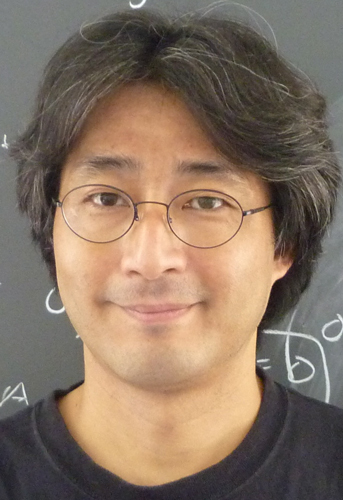Kavli Institute for the Physics and Mathematics of the Universe, University of Tokyo
The Institute will probe the biggest mysteries in modern cosmology

The Researchers
EVERYDAY AT 3 O'CLOCK IN THE AFTERNOON, members of the Kavli Institute for the Physics and Mathematics of the Universe at Tokyo University make their way down a sloped corridor and gather in a downstairs lobby for afternoon tea. Astronomers, mathematicians, string theorists, particle physicists and other researchers halt meetings, wrap up telephone calls, break from writing papers and planning projects to socialize.

Conversations inevitably spark over tea and snacks, and they often go something like this: “What are you working on? … That’s an interesting approach. How about this? … We should work together.”
Are informal daily gatherings like this unique at research institutes? Probably not. But what is unique at the Kavli IPMU is the wide range of scientists and mathematicians thrown into the mix. In less than five years, the Institute has grown from an idea to a productive and prestigious research center that studies some of the biggest questions in modern cosmology, including the nature of dark matter and dark energy, which make up 96 percent of the universe but today are completely unknown; how the first stars ignited; and what will be the ultimate fate of the cosmos. Joining pure mathematics with theoretical physics, experimental physics and observational astronomy, the Kavli IPMU gathers 200 researchers under one roof. More than half are from outside Japan.
“I don't think there's any other research institute around the world that combines all the way from pure math to observational programs, and that kind of mutual stimulation and inspiration we hope to get with this combination of disciplines,” said Hitoshi Murayama, the Institute’s young and energetic director who also holds a professorship at the University of California at Berkeley. “It is definitely unique.”
Surpassing Goals
On February 8th in Japan, the University of Tokyo (Todai) announced that The Kavli Foundation had established an endowment for the university’s Institute for the Physics and Mathematics of the Universe (IPMU). With the endowment, the Institute also became the 16th Kavli institute worldwide – the sixth in astrophysics, third in theoretical physics, and the first to be established in Japan.
But the history of IPMU goes back to Oct. 1, 2007, when it was established as one of five premier science research centers sponsored by the Japanese government as part of a new program called the World Premier International Research Center Initiative (WPI). The goal of WPI was to create globally visible research centers, where world-class science is advanced in astrophysics, materials science, cell biology, immunology, alternative energy development and nanoscience. The WPI Initiative has set specific 10-year goals for its institutes. They include building a research staff of at least 200 people, of which at least 30-percent are not Japanese; making English the institute’s official language; and pursuing scientific breakthroughs through a fusion of scientific disciplines.
“I don't think there's any other research institute around the world that combines all the way from pure math to observational programs, and that kind of mutual stimulation and inspiration we hope to get with this combination of disciplines.” – Hitoshi Murayama
Today, what is now the Kavli IPMU has not only met or surpassed the 10-year goals set by the government program, it has done so years ahead of schedule. A snapshot of the Institute finds research programs in 15 areas, including string theory, mathematics, neutrino physics, observational cosmology, inflation and the early universe, and supernovae. Its researchers are also deeply involved in four major experimental and observational projects. They include a new-wide field imaging and redshift survey of galaxies, called SuMIRe, at the Subaru Telescope atop Mauna Kea in Hawaii; a dark matter detection experiment called XMASS; and neutrino experiments called SuperKamiokande and KamLAND.
Last fall, the Kavli IPMU researcher Masamune Oguri led an international group of scientists from Harvard University, the University of Chicago, the University of Oslo, Yale University, the Max Planck Institute for Astronomy in Germany, and the National Astronomical Observatory of Japan to generate new measurements of the distribution of dark matter in the universe. The team studied gravitational lensing phenomena, the bending of light by gravity, in 28 distant galaxy clusters. Their work, which included a review of images from the Sloan Digital Sky Survey and follow-up observations using the Subaru Telescope, is helping scientists better understand how dark matter is both concentrated and distributed among galaxy clusters.
In other recent work, the Kavli IPMU researchers, again working internationally, completed a new computer simulation that suggests that the first stars were not as massive as previously believed; and detected vigorous star formation in one of the most distant and therefore earliest galaxies yet discovered. Both projects are helping cosmologists better understand how the early universe became populated with the first generation of stars, and how that led to the evolution of galaxies we see today.
While funding from the government’s WPI Initiative is limited, the University of Tokyo has recognized that its investment in the Kavli IPMU is paying off and should continue. In January of 2011, IPMU was approved as the first entity within the Todai Institutes for Advanced Study (TODIAS), a university-wide organization of research centers that conduct world-class research and further advance the university’s international profile. When he announced the Institute’s membership in TODIAS in January 2011, Murayama called the development “a critical step for IPMU to become a permanent member of the Todai community.” The additional funding from the endowment also assures the Kavli IPMU’s long-term success.
Strong Leadership
“It is really amazing that the Kavli IPMU established its present position within as short a period as four years, from scratch,” said Toshio Kuroki, program director for the WPI Initiative. Kuroki gives much of the credit to the Institute’s founding and current director. “The major reasoning behind this was undoubtedly the enthusiastic leadership of Dr. Murayama, who attracted young and senior scientists worldwide,” he said.

One of the biggest challenges in establishing the Kavli IPMU was to recruit researchers to join an Institute that by design was going to receive only temporary support from the government, said Peccei, who is also a particle physicist. Murayama’s enthusiasm for creating a new Institute that could be permanent if it was built with the right people from the beginning was infectious.
“I think that Hitoshi carried that spirit extremely well and convinced a lot of people – young people – to come and join their Institute though there was no security,” said Peccei. “I think that was remarkable.”
Murayama said he jumped at the chance in 2007 to help launch and then lead a new research institute in mathematics, physics and cosmology.
“I believed this was an unprecedented opportunity to design a major research institute based on my idea,” Murayama said. This combination of fields is unique, and I truly felt it was necessary for making big advances in our understanding of how the universe works.”
For Hirosi Ooguri, Fred Kavli Professor of Theoretical Physics and Mathematics & Deputy Chair of Physics, Mathematics and Astronomy at the California Institute of Technology in Pasadena, collaborations across disciplines are essential. Ooguri, who also conducts research at the Kavli IPMU as a principal investigator, studies superstring theory, which proposes an ultimate unified theory that can explain the physics of the universe at the smallest and largest scales. Such work requires connections among cutting-edge mathematics, experimental particle physics, and ultimately observational astrophysics.
“Mathematics and physics inspire each other because physics, especially elementary particle physics and cosmology, is really pushing the frontier of human understanding of nature,” Ooguri said. “And, as Galileo said, the universe is written in the language of mathematics. As we push to the frontier, we do need to develop new mathematics to describe what we are seeing and what we want to understand.”

Ooguri, who collaborates closely with researchers at the Kavli IPMU, said the Institute’s multi-disciplinary approach allows him to interact with a broad range of people.
“I am really delighted that it is a member of the Kavli family, Ooguri said. “From the perspective of the Kavli IPMU, it's wonderful to be recognized as a member of this elite group of institutes. This also enables it, under Hitoshi Murayama, to be able to use the funding in a very strategic way.”
With access to discretionary funding, the Institute will be able to move quickly when circumstances demand it, Ooguri said. “Sometimes, we need to seize an opportunity and put together a research project quickly. However, funding agencies may not be able to respond in a timely manner.” Recently, Ooguri and a graduate student at the University of Tokyo were working on problems related to black hole physics, and they wanted to quickly join together mathematicians, physicists and others to discuss them. IPMU was able to organize a week-long international conference within three months that was specific to their research questions.
The new injection of Kavli Foundation support will reinforce this kind of institutional agility, Ooguri said.
David Spergel, a theoretical astrophysicist from Princeton University who also is a principal investigator at the Kavli IPMU, said the Institute is an exciting place in part because most universities around the world are still organized around departments. That structure can sometimes make open collaborations challenging.
“In general, places have departments and departments have buildings,” Spergel said. “Most universities are organized around a department structure, where the math department is in the math building. Sometimes the physics and astrophysics departments are in the same building, but usually they are on different floors.”
“I think this is the only place I know of where you’ll find first-rate mathematicians and first-rate astrophysicists in the same building – and interacting regularly.”
Spergel is widely known for his work interpreting data from the WMAP satellite, which mapped cosmic microwave background radiation that dates back to within 400,000 years of the Big Bang. He is now collaborating with Kavli IPMU researchers on the upcoming galaxy survey by the Subaru Telescope, which will help researchers learn about the distribution of dark matter and the nature of dark energy.
“It’s possible that some very exciting new ideas will come out of this environment,” Spergel said of the collaborative, multi-disciplinary atmosphere at the Kavli IPMU. “I think it’s quite possible we’ll see something really exciting emerge.”